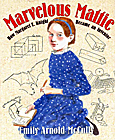 |
Nancy Keane's | Booktalks -- Quick and Simple | |
|
|||||||
 |
McCully,
Emily Arnold.
MARVELOUS
MATTIE : HOW MARGARET E. KNIGHT BECAME AN INVENTOR
New
York : Farrar, Straus and Giroux, 2006
IL
K-3, RL 3.1
ISBN
0374348103
(2 booktalks) |
|
|
Booktalk
#1
Do you like making things up? Do you think you can come up with a new invention? Well, Mattie Knight proved that you don't have to have a college education or even be an adult to invent a useful machine. Mattie lived in the 1800s and only went to elementary school. When she was 12 years old, she went to work in a textile mill in Manchester, NH. After a accident in the mill, Mattie invented a device to keep the accident from happening again. At first, the mill owner was skeptical that a child could have a good idea, but it soon was installed in all the mills in Manchester. And Mattie didn't stop there. Booktalk #2 The only thing that Mattie had from her father was his toolbox. She used the toolbox and her imagination to invent many things. When Mattie was only twelve, she designed a metal guard to prevent the shuttles from shooting off looms in the textile mills, but her biggest project was to invent a machine that could cut and glue a square bottomed grocery bag. When Charles Annan secretly stole the plans and received a patent, the persistent Mattie went to court and proved it was her invention after all. You, too, can see her wonderful inventions in the sketches on the bottom of the pages. (Jean B. Bellavance for Pennsylvania Young Reader's Choice Awards, 2007-2008) |
| SUBJECTS:
Knight, Margaret E., 1838-1914.
Inventors.
|